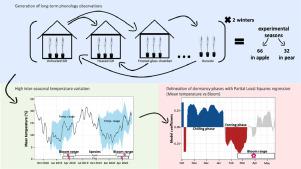Agricultural and Forest Meteorology ( IF 5.6 ) Pub Date : 2021-09-22 , DOI: 10.1016/j.agrformet.2021.108652 Eduardo Fernandez 1 , Priska Krefting 1 , Achim Kunz 2 , Hoa Do 1 , Erica Fadón 1 , Eike Luedeling 1

|
Global warming has modified the phenology of deciduous species. Temperature during the dormancy phase modulates the timing of bloom in temperate trees. Chill and heat requirements represent the climatic needs of trees during dormancy. Partial Least Squares (PLS) regression allows delineating chilling and forcing phases, which in turn allows estimating the trees’ requirements. However, PLS regression requires long-term phenology and weather data, which are scarce in many growing regions. In a two-year experiment, we generated long-term phenology data by exposing potted trees to distinct environments during winter. We obtained records for 66 and 32 experimental seasons in apple and pear, respectively. We recorded tree phenology and hourly temperature. Through PLS regression methods, we determined the impacts of inter-seasonal variation on the outputs, estimated species’ dormancy phases and needs (in Chill Portions – CP and Growing Degree Hours – GDH), and assessed the relationship between bloom and temperature during the chilling and forcing phases. Results suggest inter-seasonal variation may be more important than number of seasons for producing valuable outputs. We delineated the chilling phase from October 19 to January 04 for apple and October 19 to December 27 for pear. The forcing period for both species was January 16 – March 26. Median chill and heat requirements were estimated as 43 CP and 14,845 GDH for apple and 31 CP and 11,816 GDH for pear. Bloom was modulated by temperature during both phases under warm conditions. In cold scenarios, bloom was mostly defined by temperatures during the forcing phase. We expanded the reach of the PLS regression method and made it applicable for cultivars lacking long-term phenology data. Our approach helps dormancy researchers improve their procedures to analyze species’ responses under possible future conditions. This work may assist farmers and orchard managers in adapting their orchards to face future challenges.
中文翻译:

通过多环境观测促进温带果树寒热期的统计划分
全球变暖改变了落叶物种的物候。休眠阶段的温度会调节温带树木的开花时间。寒冷和热量需求代表休眠期间树木的气候需求。偏最小二乘 (PLS) 回归允许描绘冷却和强制阶段,进而允许估计树木的需求。然而,PLS 回归需要长期的物候和天气数据,而这在许多种植区是稀缺的。在为期两年的实验中,我们通过在冬季将盆栽树木暴露在不同的环境中来生成长期物候数据。我们分别获得了苹果和梨的 66 和 32 个试验季的记录。我们记录了树木物候和每小时温度。通过PLS回归方法,我们确定了季节间变化对产量的影响,估计物种的休眠阶段和需求(寒冷部分 - CP 和生长时间 - GDH),并评估了寒冷和强迫阶段开花与温度之间的关系。结果表明,对于生产有价值的产品,季节间变化可能比季节数更重要。我们将苹果的冷却期划分为 10 月 19 日至 1 月 4 日,梨的冷却期为 10 月 19 日至 12 月 27 日。这两个物种的强迫期为 1 月 16 日至 3 月 26 日。中值冷热需求估计为苹果 43 CP 和 14,845 GDH,梨的 31 CP 和 11,816 GDH。在温暖条件下,在两个阶段期间,Bloom 受温度调节。在寒冷的情况下,绽放主要由强迫阶段的温度定义。我们扩展了 PLS 回归方法的范围,使其适用于缺乏长期物候数据的品种。我们的方法帮助休眠研究人员改进他们的程序,以分析未来可能条件下物种的反应。这项工作可以帮助农民和果园管理者调整他们的果园以应对未来的挑战。











































 京公网安备 11010802027423号
京公网安备 11010802027423号